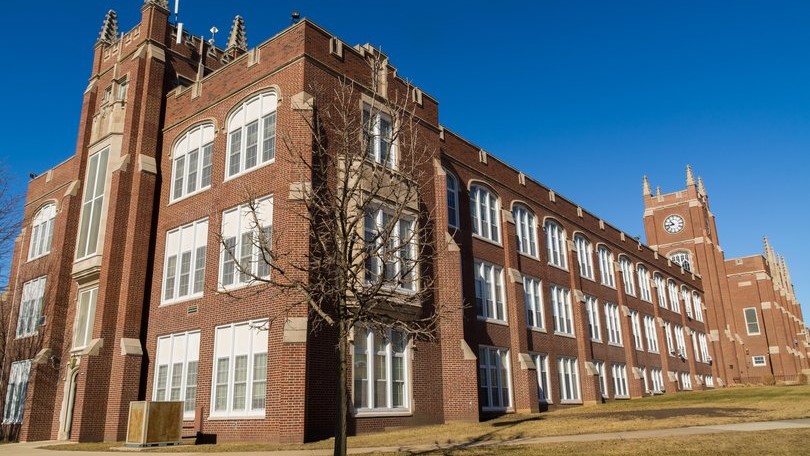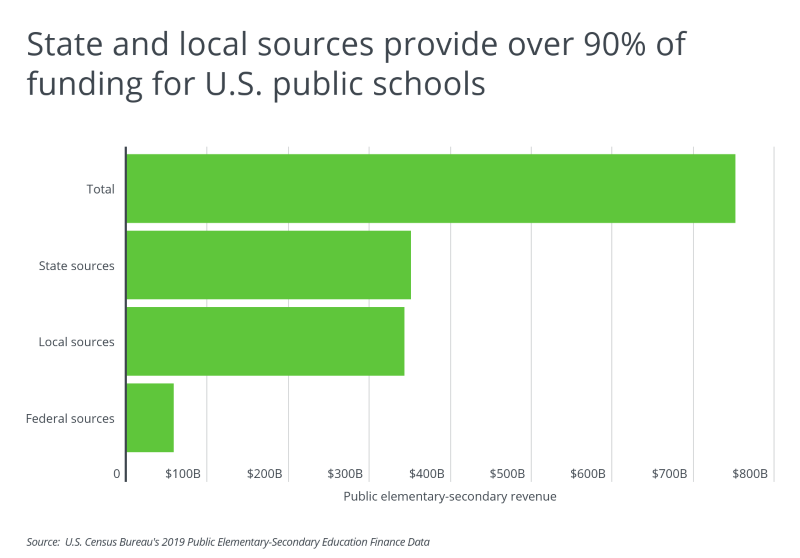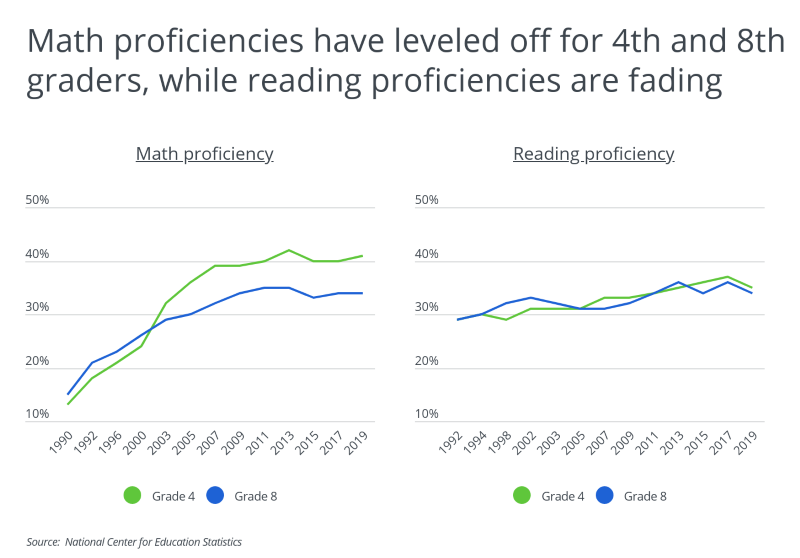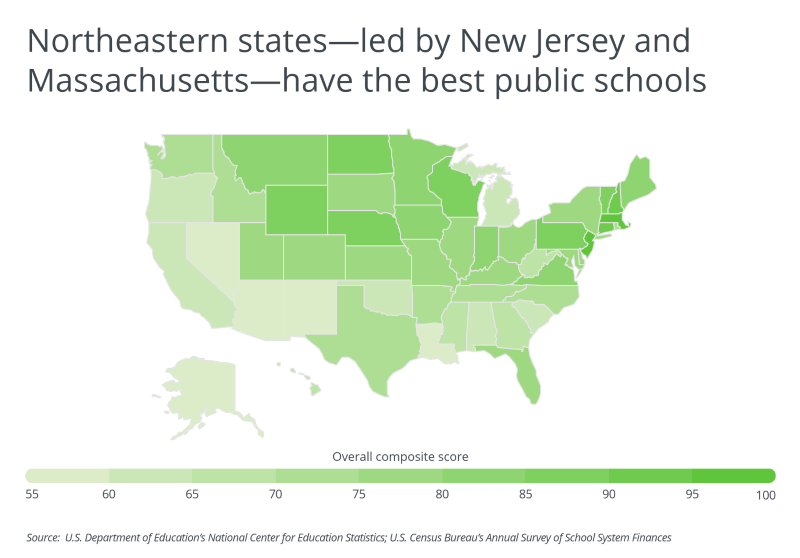States with the Best Public Schools since the Pandemic
 Photo Credit: Alamy Stock Photo
Photo Credit: Alamy Stock Photo
July 15th, 2021
The pandemic transformed American life in many ways, but arguably none quite as severely as education.
In spring 2020, many schools across the country closed their doors to in-person learning as scientists and politicians grappled with the dangers of COVID-19. Globally, more than 1 billion students were affected by school closures. The effects of those closures were felt not just by students, but by parents and educators too.
Parents were forced to deal with tough choices: send their children to school or start an at-home learning program? Educators had to manage the transition from teaching in a classroom to teaching on a computer. Many students transitioned from a pre-pandemic routine of going to class, seeing friends, and talking with teachers to a new reality of learning exclusively through a computer or mobile device.
New York and Alaska stand out as states that have significantly above average funding per student, but report below average academic results...Idaho and Utah have the lowest public education spending per student of all 50 states, but achieve significantly above average scores on the NAEP.
Before the upheaval started, school districts already faced scrutiny over the quality of education they provided. Data from the Nation's Report Card showed that math and reading proficiencies were stagnant leading up to the pandemic. Many locations with less funding per student struggled to stay above national testing averages. With more than 90% of school funding coming from state and local sources, the pandemic highlighted disparities in the nation's education system and jeopardized the performance of students in communities that were already falling behind.

Even before the pandemic struck, national trends indicated that students' math and reading proficiencies were at concerning levels. Data from the National Assessment of Education Progress (NEAP) show that math proficiencies leveled off for eighth-graders at around 33% and increased slightly to 41% among fourth-graders in 2019. Reading proficiency peaked in 2017 but declined in the next round of testing. In 2019, both grade levels were at or below 35% proficiency.

Yet while the national data indicates that many students struggle with math and reading, state-level statistics show that certain states have found a way to buck the national trend. To determine the states with the best public schools, researchers at HireAHelper used data from the U.S. Department of Education and the Census Bureau to generate a composite score based on the following weighted factors:
- NAEP reading scores (25%): the difference between the state reading score and the national average for fourth- and eighth-grade students on the NAEP exam.
- NAEP math scores (25%): the difference between the state math score and the national average for fourth- and eighth-grade students on the NAEP exam.
- Total state spending per student (10%): the total elementary-secondary per-pupil spending on instruction, support services, and other functions.
- Pupil-teacher ratio (20%): the number of public school students per teacher.
- Graduation rate (20%): the public high school four-year adjusted cohort graduation rate.

In many cases, the states with the best test scores are also the states that spend the most money per student—as is the case for Connecticut, New Jersey, Vermont, and Massachusetts. But this trend is inconsistent. New York and Alaska stand out as states that have significantly above average funding per student, but report below average academic results. On the other hand, Idaho and Utah have the lowest public education spending per student of all 50 states, but achieve significantly above average scores on the NAEP.
When taking all these factors into account—test scores, funding, student-teacher ratios, and graduation rates—the states with the best public education systems are disproportionately concentrated in the Northeast. Here are the states with the best public schools.
States with the Best Public Schools
 Photo Credit: Alamy Stock Photo
Photo Credit: Alamy Stock Photo15. Indiana
- Overall composite score: 80.8
- Reading scores (difference from national average): +3.5 points
- Math scores (difference from national average): +5.0 points
- Total state spending per student: $10,397
- Pupil-teacher ratio: 17.3
- Graduation rate: 87%
 Photo Credit: Alamy Stock Photo
Photo Credit: Alamy Stock Photo14. Minnesota
- Overall composite score: 80.9
- Reading scores (difference from national average): +2.5 points
- Math scores (difference from national average): +9.0 points
- Total state spending per student: $13,387
- Pupil-teacher ratio: 15.4
- Graduation rate: 84%
 Photo Credit: Alamy Stock Photo
Photo Credit: Alamy Stock Photo13. Montana
- Overall composite score: 81.2
- Reading scores (difference from national average): +3.0 points
- Math scores (difference from national average): +2.0 points
- Total state spending per student: $11,988
- Pupil-teacher ratio: 14.1
- Graduation rate: 87%
 Photo Credit: Alamy Stock Photo
Photo Credit: Alamy Stock Photo12. Maine
- Overall composite score: 83.6
- Reading scores (difference from national average): +2.5 points
- Math scores (difference from national average): +1.0 points
- Total state spending per student: $14,614
- Pupil-teacher ratio: 12.0
- Graduation rate: 87%
 Photo Credit: Alamy Stock Photo
Photo Credit: Alamy Stock Photo11. Virginia
- Overall composite score: 84.8
- Reading scores (difference from national average): +2.5 points
- Math scores (difference from national average): +6.5 points
- Total state spending per student: $12,641
- Pupil-teacher ratio: 14.8
- Graduation rate: 88%
 Photo Credit: Alamy Stock Photo
Photo Credit: Alamy Stock Photo10. Pennsylvania
- Overall composite score: 85.4
- Reading scores (difference from national average): +3.0 points
- Math scores (difference from national average): +4.0 points
- Total state spending per student: $16,864
- Pupil-teacher ratio: 14.0
- Graduation rate: 87%
 Photo Credit: Alamy Stock Photo
Photo Credit: Alamy Stock Photo9. Nebraska
- Overall composite score: 85.9
- Reading scores (difference from national average): +2.5 points
- Math scores (difference from national average): +4.0 points
- Total state spending per student: $12,743
- Pupil-teacher ratio: 13.6
- Graduation rate: 88%
 Photo Credit: Alamy Stock Photo
Photo Credit: Alamy Stock Photo8. North Dakota
- Overall composite score: 86.9
- Reading scores (difference from national average): +1.5 points
- Math scores (difference from national average): +4.0 points
- Total state spending per student: $14,004
- Pupil-teacher ratio: 12.0
- Graduation rate: 88%
 Photo Credit: Alamy Stock Photo
Photo Credit: Alamy Stock Photo7. Wisconsin
- Overall composite score: 87.3
- Reading scores (difference from national average): +3.0 points
- Math scores (difference from national average): +5.0 points
- Total state spending per student: $12,598
- Pupil-teacher ratio: 14.4
- Graduation rate: 90%
 Photo Credit: Alamy Stock Photo
Photo Credit: Alamy Stock Photo6. Vermont
- Overall composite score: 87.4
- Reading scores (difference from national average): +4.5 points
- Math scores (difference from national average): +2.5 points
- Total state spending per student: $20,315
- Pupil-teacher ratio: 10.5
- Graduation rate: 85%
 Photo Credit: Alamy Stock Photo
Photo Credit: Alamy Stock Photo5. Wyoming
- Overall composite score: 87.5
- Reading scores (difference from national average): +5.5 points
- Math scores (difference from national average): +5.5 points
- Total state spending per student: $16,304
- Pupil-teacher ratio: 12.9
- Graduation rate: 82%
 Photo Credit: Alamy Stock Photo
Photo Credit: Alamy Stock Photo4. New Hampshire
- Overall composite score: 93.3
- Reading scores (difference from national average): +5.5 points
- Math scores (difference from national average): +5.5 points
- Total state spending per student: $17,462
- Pupil-teacher ratio: 12.2
- Graduation rate: 88%
 Photo Credit: Alamy Stock Photo
Photo Credit: Alamy Stock Photo3. Connecticut
- Overall composite score: 94.3
- Reading scores (difference from national average): +6.5 points
- Math scores (difference from national average): +4.0 points
- Total state spending per student: $21,310
- Pupil-teacher ratio: 12.3
- Graduation rate: 89%
 Photo Credit: Alamy Stock Photo
Photo Credit: Alamy Stock Photo2. Massachusetts
- Overall composite score: 95.0
- Reading scores (difference from national average): +11.5 points
- Math scores (difference from national average): +10.0 points
- Total state spending per student: $17,748
- Pupil-teacher ratio: 13.0
- Graduation rate: 88%
 Photo Credit: Alamy Stock Photo
Photo Credit: Alamy Stock Photo1. New Jersey
- Overall composite score: 98.0
- Reading scores (difference from national average): +8.0 points
- Math scores (difference from national average): +8.5 points
- Total state spending per student: $20,512
- Pupil-teacher ratio: 12.0
- Graduation rate: 91%
Detailed Findings & Methodology
The data used in this analysis is from the U.S. Department of Education's National Center for Education Statistics and the United States Census Bureau's Annual Survey of School System Finances. To determine the states with the best public schools, researchers created an overall composite score based on the following factors for public school students:
- NAEP reading scores: the average difference between the state reading score and the national average for fourth-grade and eighth-grade students on the National Assessment of Educational Progress exam
- NAEP math scores: the average difference between the state math score and the national average for fourth-grade and eighth-grade students on the National Assessment of Educational Progress exam
- Total state spending per student: the total elementary-secondary per-pupil spending on instruction, support services, and other functions.
- Pupil-teacher ratio: the number of public school students per teacher
- Graduation rate: the public high school four-year adjusted cohort graduation rate